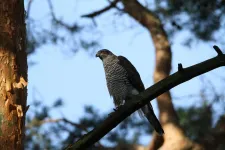Domestication and industrialisation lead to similar changes in gut microbiota
Animal domestication and industrialisation in human populations have impacted gut microbiota in related ways, likely through similar ecological changes
2021-03-23
(Press-News.org) Domestication has a consistent effect on the gut microbiota of animals and is similar to the effects of industrialisation in human populations, with ecological differences such as diet having a strong influence.
These findings, published today in eLife, highlight how the flexibility of the gut microbiota can help animals respond to ecological change and could help identify ways of manipulating gut microbial communities in the service of health.
Animals typically have complex communities of microbes living in their gut that can strongly influence functions such as immunity and metabolism. These communities can be extremely diverse and differ greatly between species and even individuals. We know, for instance, that domesticated animals, such as lab mice, have different gut microbial communities than their wild relatives. We have even seen large changes in the gut microbiota of industrialised human populations, some of which have been linked to the rise of certain diseases.
During domestication, animals experienced profound ecological changes that likely shaped their gut microbiota. "Domesticated animals and industrialised human populations potentially experienced similar ecological changes such as less diverse, more easily digestible diets, higher population densities, and more medical interventions," explains first author Aspen Reese, who was a postdoctoral Junior Fellow in the Society of Fellows, Harvard University, US, at the time the study was carried out, and is now Assistant Professor at the University of California, San Diego, US. "We wanted to find out if domestication had consistent effects on the gut microbiota of animals and if the effects were indeed similar to those of industrialisation in humans."
To assess the effects of domestication, the team sequenced and compared microbial DNA extracted from fecal samples of 18 species of wild and domesticated mammals. They found that domestication did have a clear global effect on gut microbiota, although the specific differences depended on the species.
Domestication involves strong selection pressure on animals, leading to important genetic and physiological changes that may also affect gut microbial communities. To unpack the relative roles of ecology and genetics, the team then swapped the diets of wild and domesticated animals. They found that the gut microbial communities of related animals, such as wolves and dogs, became much more similar to one another, supporting the idea that altered diets explain at least some of the changes in the gut microbiota seen with domestication.
To understand whether such differences also occur in humans, they then compared the gut microbial communities of humans to those of chimpanzees, one of our closest living relatives, and between humans living in industrialised versus non-industrialised populations. They found that differences between the gut microbiota of humans and chimpanzees were similar to those seen between domesticated and wild animals, with the largest changes evident in industrialised populations. Because all humans are equally related to chimpanzees, these results showed that ecological factors rather than genetics drive aspects of the gut microbiota shared between domesticated animals and humans living in industrialised populations.
"Our research highlights that the flexibility of the gut microbiota likely helps animals and humans respond to rapid ecological change," concludes senior author Rachel Carmody, Assistant Professor in the Department of Human Evolutionary Biology at Harvard University. "But, at the same time, this flexibility can create opportunities for mismatch between the gut microbiota we have and the one our bodies have evolved to expect. As we increasingly appreciate the central role of the gut microbiota in biology, understanding the factors that shape it in animals and humans may help us identify new ways to improve experimental animal models, the wellbeing of animals we depend on, and ultimately, human health."
INFORMATION:
Media contact
Emily Packer,
Media Relations Manager
eLife
e.packer@elifesciences.org
+44 (0)1223 855373
About eLife
eLife is a non-profit organisation created by funders and led by researchers. Our mission is to accelerate discovery by operating a platform for research communication that encourages and recognises the most responsible behaviours. We aim to publish work of the highest standards and importance in all areas of biology and medicine, including Ecology and Evolutionary Biology, while exploring creative new ways to improve how research is assessed and published. eLife receives financial support and strategic guidance from the Howard Hughes Medical Institute, the Knut and Alice Wallenberg Foundation, the Max Planck Society and Wellcome. Learn more at https://elifesciences.org/about.
To read the latest Ecology research published in eLife, visit https://elifesciences.org/subjects/ecology.
And for the latest in Evolutionary Biology, see https://elifesciences.org/subjects/evolutionary-biology.
ELSE PRESS RELEASES FROM THIS DATE:
2021-03-23
A new study co-authored by a Tulane University geoscientist shows that human efforts to tame the Mississippi River may have had an unintended positive effect: more rapid transport of carbon to the ocean.
The paper, published in AGU Advances, describes the work of a team of researchers who set out to learn more about the fate of organic carbon that is transported in large quantities by the Mississippi River. Organic carbon is mainly derived from plant remains, soils, and rocks, throughout the drainage basin of the Mississippi River that covers about 40% of the United States.
"We estimate that over the past century, the amount of organic carbon lost to the atmosphere during Mississippi River transport to the Gulf of Mexico ...
2021-03-23
"Several countries, including the United Kingdom and Canada have stated that they will delay second doses of COVID-19 vaccines in response to supply shortages, but also in an attempt to rapidly increase the number of people immunized," explains Chadi Saad-Roy, a graduate student in the Departments of Ecology and Evolutionary Biology (EEB) and Quantitative and Computational Biology in the Lewis-Sigler Institute at Princeton and the lead author of the study.
"The original clinical trials of the vaccines, plus subsequent epidemiology, are quite optimistic regarding the efficacy of the first dose. However, ...
2021-03-23
Featured on the cover of the Soil Science Society of America Journal, researchers at the University of Maryland (UMD) and the Spanish National Research Council partnered to create a new camera allowing for the imaging of wetland soil activity in real time. This camera gives the classic IRIS (indicator of reduction in soils) technology a big upgrade. IRIS is used universally by researchers and soil assessors to determine if soils are behaving like wetland soils and should therefore be classified as such. However, before this new camera, soil assessors couldn't quantify the rate of iron reduction in saturated wetland soils, and ...
2021-03-23
BOSTON - An analysis of sex differences in the genetics of schizophrenia, bipolar disorder and major depressive disorders indicates that while there is substantial genetic overlap between males and females, there are noticeable sex-dependent differences in how genes related to the central nervous system, immune system, and blood vessels affect people with these disorders.
The findings, from a multinational consortium of psychiatric researchers including investigators and a senior author at Massachusetts General Hospital (MGH), could spur better treatments for major psychiatric disorders. They are published in the journal Biological Psychiatry.
The findings were made possible only through the cooperation of more than 100 investigators and research groups, ...
2021-03-23
A new technique that can trace which tissues and organs the DNA in our blood comes from has been reported today in the open-access eLife journal.
The method, called GETMap, could be used in prenatal screening, to monitor organ transplant rejection, or test for cancers that are concealed in the body.
"Analysis of circulating free DNA has been shown to be useful for screening for early asymptomatic cancers," explains first author Wanxia Gai, Postdoctoral Fellow at the Chinese University of Hong Kong, Hong Kong SAR, China. "As cancer-associated DNA changes are present in ...
2021-03-23
In a letter to The New England Journal of Medicine, published online March 23, 2021, a group of investigators from University of California San Diego School of Medicine and the David Geffen School of Medicine at UCLA report COVID-19 infection rates for a cohort of health care workers previously vaccinated for the novel coronavirus.
"Because of the compulsory daily symptom screening of health care personnel, patients, and visitors, and the high testing capacity at both UC San Diego Health and UCLA Health, we were able to identify symptomatic and asymptomatic infections among health care workers at our institutions," said co-author ...
2021-03-23
Boulder, Colo., USA: When geobiology graduate student Katie Maloney trekked into the mountains of Canada's remote Yukon territory, she was hoping to find microscopic fossils of early life. Even with detailed field plans, the odds of finding just the right rocks were low. Far from leaving empty-handed, though, she hiked back out with some of the most significant fossils for the time period.
Eukaryotic life (cells with a DNA-containing nucleus) evolved over two billion years ago, with photosynthetic algae dominating the playing field for hundreds of millions of years as oxygen accumulated in the Earth's atmosphere. Geobiologists think that algae evolved first in freshwater environments ...
2021-03-23
Over the past decades, the increased use of chemicals in many areas led to environmental pollution - of water, soil and also wildlife. In addition to plant protection substances and human and veterinary medical drugs, rodenticides have had toxic effects on wildlife. A new scientific investigation from scientists of the Leibniz Institute for Zoo and Wildlife Research (Leibniz-IZW), the Julius Kühn Institute (JKI) and the German Environment Agency (Umweltbundesamt - UBA) demonstrate that these substances are widely found in liver tissues of birds of prey from Germany. Anticoagulant rodenticides, commonly used to kill rodents in agriculture and forestry, were frequently detected, particularly in birds of prey close to or in urban environments. ...
2021-03-23
DALLAS - March 23, 2021 - Vaccinating health care workers resulted in an immediate and notable reduction of positive COVID-19 cases among employees, reducing the number of required isolations and quarantines by more than 90 percent, according to data at UT Southwestern Medical Center published in the New England Journal of Medicine.
Health care workers were among the first groups to be eligible for vaccination.
"Real-world experience with SARS-CoV-2 vaccination at UT Southwestern demonstrated a marked reduction in the incidence of infections among our employees, preserving the workforce when it was most needed," notes Daniel K. Podolsky, M.D., president of UT Southwestern and senior author.
During ...
2021-03-23
ITHACA, N.Y. - New research from Mildred Warner, professor of city and regional planning at Cornell University, shows that state laws designed to hinder union activity and indulge corporate entities do not enhance economic productivity.
"We find that where state policy is captured by corporate interests, this undermines inclusive growth," Warner said. "These interests see union and city power as a threat, which is why there are groups like the American Legislative Exchange Council, for example, focused on crafting state laws that erode labor protections and enhance corporate interests."
The ...
LAST 30 PRESS RELEASES:
[Press-News.org] Domestication and industrialisation lead to similar changes in gut microbiota
Animal domestication and industrialisation in human populations have impacted gut microbiota in related ways, likely through similar ecological changes



